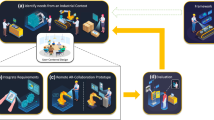Abstract
This paper presents an approach to managing knowledge specific to a particular location for complex instruments. The goal is to improve the knowledge communication between experts and end-users of scientific instruments. We propose a computational framework that integrates augmented reality and augmented virtuality as interface for manipulating knowledge. The augmented virtuality-based interface can be produced and distributed without extra costs. It allows knowledge dissemination at a larger scale. The prominent feature of our model is that the knowledge representation is independent from those interfaces. A preliminary version of our framework has been implemented and deployed in customers’ environments.












Similar content being viewed by others
References
Azuma R (1997) A survey of augmented reality. Presence Teleoperators Virtual Environ 6(4):355–385
Azuma R, Baillot Y, Behringer R, Feiner S, Julier S, MacIntyre B (2001) Recent advances in augmented reality. Comput Graph Appl 25:24–35
Barfield W, Caudell T (2000) Fundamentals of wearable computers and augmented reality. L. Erlbaum, Hillsdale
Drummond T, Cipolla R (2002) Real-time visual tracking of complex structures. IEEE Trans PAMI 24(7):932–946. doi:10.1109/TPAMI.2002.1017620
Feiner S, Macintyre B, Seligmann D (1993) Knowledge-based augmented reality. Commun ACM 36(7):53–62. doi:10.1145/159544.159587
Fischer G, Ostwald J (2001) Knowledge management: problems, promises, realities, and challenges. IEEE Intell Syst 16(1):60–72
Franken T, Dellepiane M, Ganovelli F, Cignoni P, Montani C, Scopigno R (2005) Minimizing user intervention in registering 2D images to 3D models. Vis Comput 21(8–10):619–628 special issues for pacific graphics 2005
Gao XS, Hou XR, Tang J, Cheng HF (2003) Complete solution classification for the perspective-three-point problem. IEEE Trans PAMI 25(8):930–943. doi:10.1109/TPAMI.2003.1217599
Goose S, Guven S, Zhang X, Sudarsky S, Navab N (2004) PARIS: Fusing vision-based location tracking with standards-based 3D visualization and speech interaction on a PDA. In: International conference on distributed multimedia systems, San Francisco, USA, pp 75–80
Huber PJ (1981) Robust statistics. Wiley, New York
Huttenlocher DP, Ullman S (1990) Recognizing solid objects by alignment with an image. Int J Comput Vis 5(2):195–212. doi:10.1007/BF00054921
Igarashi T, Hughes JF (2001) A suggestive interface for 3D drawing. In: 14th Annual symposium on user interface software and technology, Orlando, FL, pp 173–181
Igarashi T, Matsuoka S, Tanaka H (1999) Teddy: a sketching interface for 3D freeform design. In: The 26th annual conference on computer graphics and interactive techniques (SIGGRAPH), ACM Press, Los Angels, pp 409–416
Lowe DG (1987) Three-dimensional object recognition from single two-dimensional images. Artif Intell 31(3):355–395
Malis E, Marchand E (2006) Experiments with robust estimation techniques in real-time robot vision. In: IEEE/RSJ IROS ‘06, Beijing, China, pp 223–228
Masry M, Kang DJ, Lipson H (2005) A freehand sketching interface for progressive construction of 3D objects. Comput Graph 29(4):563–575
Matsushita K, Kaneko T (1999) Efficient and handy texture mapping on 3D surfaces. In: Brunet P, Scopigno R (eds) Computer graphics forum. Eurographics Association and Blackwell, vol 18(3), pp 349–358. http://www3.interscience.wiley.com/journal/119071638/abstract?CRETRY=1&SRETRY=0
Merckel L, Nishida T (2008a) Accurate object recognition using orientation sensor with refinement on the lie group of spatial rigid motions. IEICE Trans Inf Syst E91-D(8):2179–2188
Merckel L, Nishida T (2008b) Evaluation of a method to solve the perspective-two-point problem using a three-axis orientation sensor. In: The 8th international conference on information technology (CIT), IEEE Computer Society, Sydney, Australia, pp 862–867
Merckel L, Nishida T (2009) Enabling situated knowledge management for complex instruments by real-time reconstruction of surface coordinate system on a mobile device. AI Soc 24(1):85–95. doi:10.1007/s00146-009-0200-y
Milgram P, Colquhoun H (1999) A taxonomy of real and virtual world display integration. In: Ohta Y, Tamura H (eds) Mixed reality-merging real and virtual worlds, chap 1. Ohmsha (Tokyo), Springer (Berlin), pp 5–30
Miller G, Talmor D, Teng S, Walkington N, Wang H (1996) Control volume meshes using sphere packing: generation, refinement and coarsening. In: The 5th international meshing roundtable, Pittsburgh, PA, pp 47–61
Mizell DW (1994) Virtual reality and augmented reality in aircraft design and manufacturing. In: IEEE WESCON, p 91
Neugebauer P, Klein K (1999) Texturing 3D models of real world objects from multiple unregistered photographic views. Comput Graph Forum 18(13):245–256
Nishida T (2007) Social intelligence design and human computing. In: Huang TS et al. (eds) Human Comput LNAI, vol 4451, pp 190–214
Nishida T, Terada K, Tajima T, Hatakeyama M, Ogasawara Y, Sumi Y, Xu Y, Mohammad YFO, Tarasenko K, Ohya T, Hiramatsu T (2006) Toward robots as embodied knowledge media. IEICE Trans Inf Syst E89-D(6):1768–1780
Pearson RK (2002) Outliers in process modeling and identification. IEEE Trans Control Syst Technol 10(1):55–63
Reitmayr G, Eade E, Drummond T (2007) Semi-automatic annotations in unknown environments. In: Proceedings of ISMAR 2007, Nara, Japan, pp 67–70
Riess P, Stricker D (2006) AR-on-demand: a practicable solution for augmented reality on low-end handheld devices. In: AR/VR Workshop of the Germany Computer Science Society, Coblence, Germany, pp 119–130
Rose E, Breen D, Ahlers KH, Crampton C, Tuceryan M, Whitaker R, Greer D (1995) Annotating real-world objects using augmented reality. In: Computer Graphics International, Leeds, UK, pp 357–370
Shewchuk JR (1998) Tetrahedral mesh generation by Delaunay refinement. In: The 14th annual symposium on computational geometry, pp 86–95
Si H (2006) On refinement of constrained Delaunay tetrahedralizations. In: The 15th international meshing roundtable
Si H, Gaertner K (2005) Meshing piecewise linear complexes by constrained Delaunay tetrahedralizations. In: The 14th international meshing roundtable, pp 147–163
Stuerzlinger W (1999) Imaging all visible surfaces. In: The 1999 conference on graphics interface, Morgan Kaufmann, San Francisco, CA, pp 115–122
van Dam A (1997) Post-wimp user interfaces. Commun ACM 40(2):63–67. doi:10.1145/253671.253708
Zeleznik RC, Herndon KP, Hughes JF (1996) Sketch: an interface for sketching 3D scenes. In: The 23rd annual conference on computer graphics and interactive techniques (SIGGRAPH), ACM, New York, NY, pp 163–170
Author information
Authors and Affiliations
Corresponding author
Rights and permissions
About this article
Cite this article
Merckel, L., Nishida, T. Multi-interfaces approach to situated knowledge management for complex instruments: first step toward industrial deployment. AI & Soc 25, 211–223 (2010). https://doi.org/10.1007/s00146-009-0247-9
Received:
Accepted:
Published:
Issue Date:
DOI: https://doi.org/10.1007/s00146-009-0247-9




